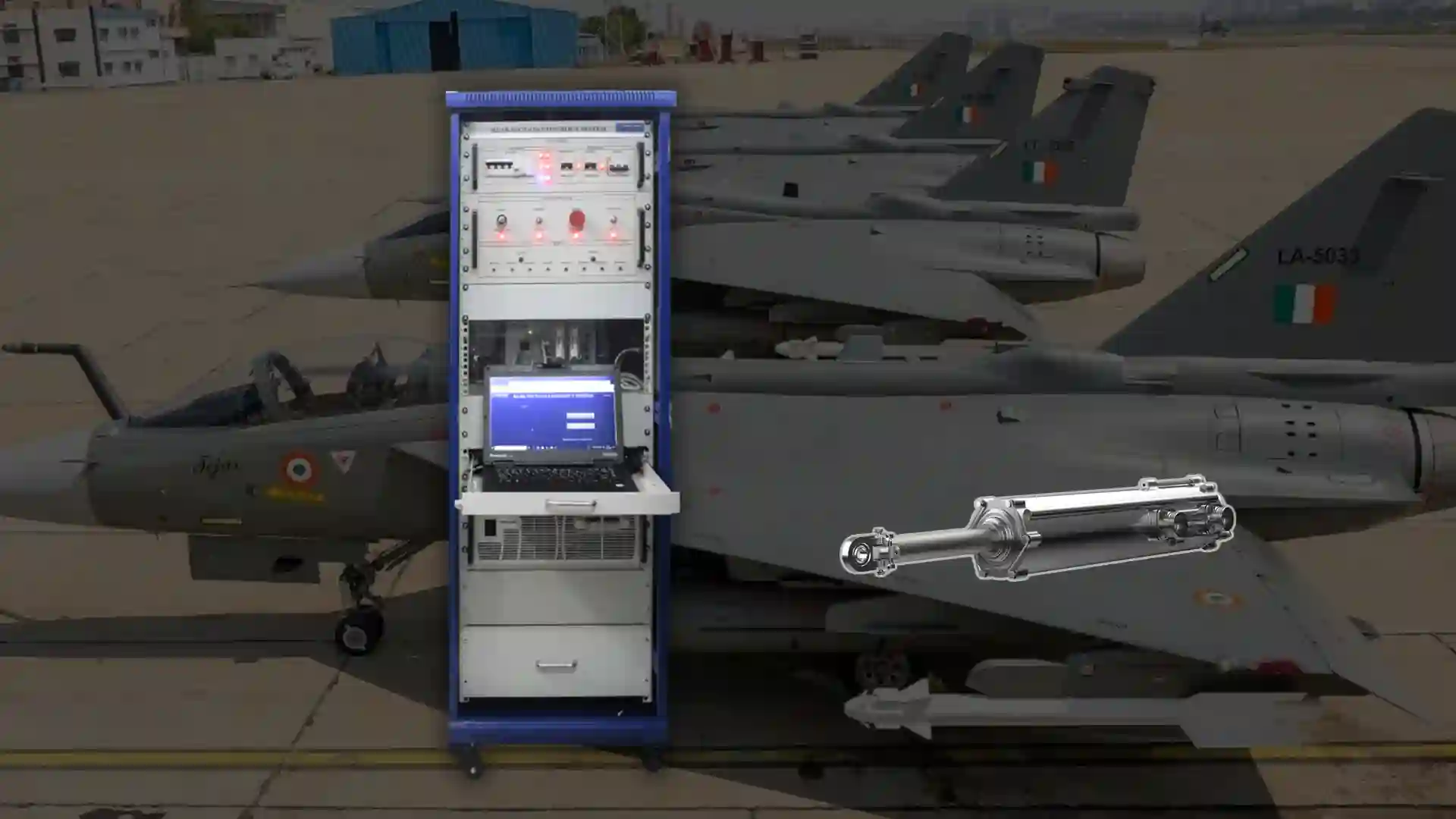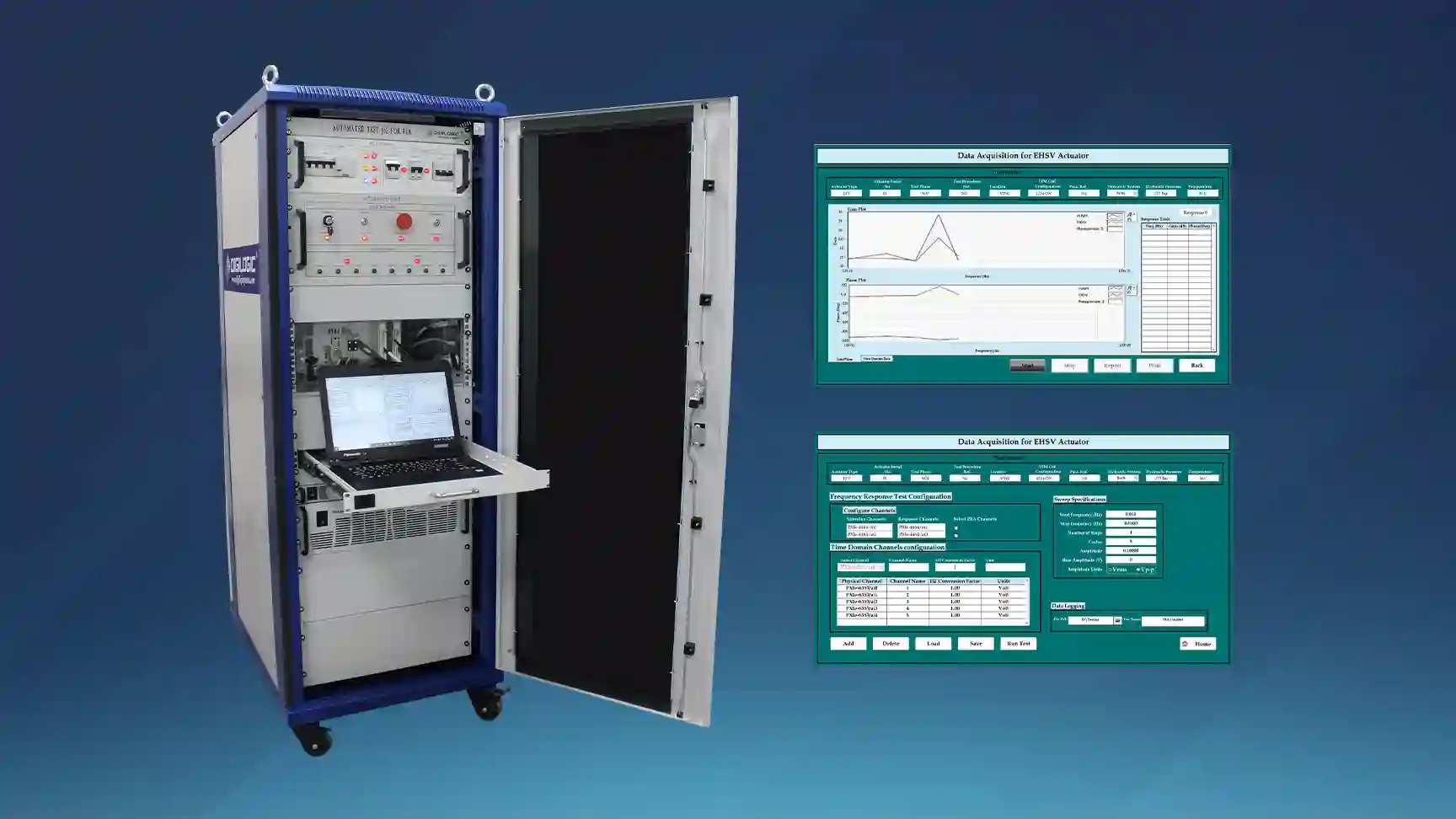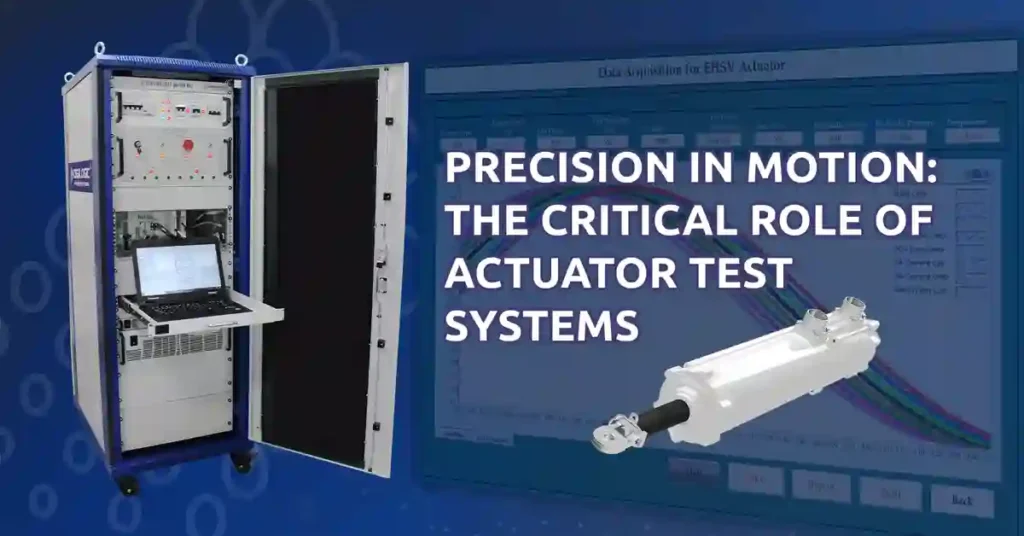Introduction:
In today’s rapidly evolving industrial landscape, the reliability and performance of actuator systems determine the success of countless applications ranging from aerospace flight controls to automotive safety systems. As precision requirements continue to escalate and operational environments become increasingly demanding, the need for comprehensive actuator testing has never been more critical.

The Foundation of Reliable Motion Control
An Actuator Test System (ATS) is far more than a simple validation setup, it is a comprehensive integration of precision instruments, control electronics, load simulation, and analytical software. Modern ATS solutions, like those engineered by Digilogic Systems are built on modular architectures such as PXI, known for their flexibility and scalability. A scalable PXI enabled system consists of:
PXI Chassis & Embedded Controller: The operational hub housing a synchronous backplane and running on a Host based OS (or) Real-Time OS with an application software.
Multifunction DAQ Modules: Modules with precise ADCs used to capture essential parameters like position, velocity, force, and electrical signals with high resolution.
Servo Controllers & Load Simulation Units: Replicating operational stresses and motion profiles for realism.
The versatility of such platforms allows a single ATS to handle electromechanical, hydraulic, and pneumatic actuators with both static and dynamic testing capabilities.
Frequency Response Analysis: Profiling Dynamic Performance of Actuators
One of the most crucial components of a sophisticated ATS is the Frequency Response Analysis (FRA). While static tests validate range and linearity, FRA measures how the actuator behaves dynamically under varying conditions.
Why FRA Matters
An actuator is often part of a feedback-controlled (closed-loop) system. Its gain, phase, and bandwidth dictate how closely it can follow commands without overshoot, lag, or instability. FRA exposes these characteristics by applying controlled sinusoidal inputs over a range of frequencies, creating Bode plots that serve as unique fingerprints depicting an actuators behaviour.
Key FRA Capabilities:
Swept Sine & Step Excitation: Supporting precise system characterization and dynamic response validation.
Time & Frequency Domain Analysis: Providing engineers with granular insight for system tuning.
Portability: Enabling lab or field deployment for production/commissioning or maintenance.
Scalability: Handling increasing channel counts for multi-axis actuator testing.
Actuator Types and Testing Focus
Electromechanical Actuators: Precision, Efficiency, and Connectivity
Electromechanical actuators have grown in prominence due to their energy efficiency, clean operation, and precise controllability. They use mechanisms like ball screws, roller screws, and linear motors to convert rotary motor output into smooth, linear motion.
Modern Advancements:
- Smart Sensors for position, temperature, and torque monitoring.
- IoT Integration for real-time health tracking and cloud-based analytics.
- Predictive Maintenance powered by onboard diagnostics.
Testing Focus Areas:
- Linear displacement accuracy under full load.
- Velocity profile validation against programmed motion curves.
- Thermal behavior during prolonged duty cycles.
- FRA-based bandwidth and phase margin assessment.
ATS platforms verify these capabilities with rigorous positional accuracy tests before approval, achieving positioning tolerances within meters.
Hydraulic Actuators: Delivering Power Under Pressure
Hydraulic actuators dominate in high-force, heavy-duty applications, ranging from aerospace flight controls to industrial presses where force density and instantaneous power delivery are paramount. Force transmission is essentially instantaneous due to the incompressibility of hydraulic fluids.
Testing Procedures Include:
- Proof Pressure to confirm operational safety margins.
- Internal & External Leakage Testing to ensure efficiency and reliability.
- Dynamic Velocity & Step Response under simulated high-load conditions.
- Frequency Response Characterization using precision FRA setups.
- Extended Endurance Cycling for aerospace-grade qualification.
Example: In a combat aircraft, hydraulic actuators powering control surfaces undergo thousands of simulated mission cycles, with real-time monitoring of parameters like temperature, fluid pressure, and piston speed within ±0.1% accuracy.
Pneumatic Actuators: Speed and Simplicity in Automation
Pneumatic actuators utilize compressed air or gases to produce rapid mechanical motion, offering unique advantages in applications requiring fast cycling, clean operation, and simple installation. These systems excel in end-to-end positioning tasks and provide reliable operation in harsh environmental conditions.
The compressible nature of pneumatic media results in inherently different performance characteristics compared to hydraulic systems.
Key Testing Metrics:
- Fast-Cycling Endurance for high-volume production environments.
- Environmental Testing for resistance to dust, moisture, and vibration.
- Dynamic Frequency Analysis to determine maximum reliable cycling rates.
Advanced Testing Methodologies and Compliance
Digilogic Systems Actuator Test System (ATS) methodology closely aligns with leading industry and regulatory standards, such as ISO, MIL-STD, and RTCA DO-160, for actuator testing in aerospace, defence, and industrial applications.

How Digilogic’s ATS Methodologies Reflect the Standards:
Static Performance Testing
ATS performs static tests including endurance/cyclic testing, null position stability, linearity checks, scale factor validation, threshold detection, and coil current-force calibration. These procedures correspond with standard practices under ISO and MIL-STD guidelines, which require precise, repeatable verification of actuator fundamental performance before advanced dynamic testing.
Dynamic Performance Testing
The system is equipped to conduct advanced dynamic performance tests, such as step response analysis, velocity profiling, and full-spectrum frequency response analysis (FRA). These tests map the actuator’s response to rapid changes and oscillatory inputs to analyse the control system stability and bandwidth validation.
Environmental Stress Testing
Digilogic Systems ATS can seamlessly integrate with environmental chambers, enabling automated testing under controlled temperature and humidity conditions. These can include cycles of temperature, humidity, vibration, shock, and electromagnetic interference—by synchronizing with chamber controls for comprehensive system evaluation.
Integration with Modern Intelligent Actuators
Digilogic’s ATS platform is designed to address the sophisticated requirements by enabling:
- Verification of on-board encoders to ensure accurate measurement and feedback.
- Validation of communication integrity including handshake protocols and error tolerance, critical for reliable industrial network operation.
- Testing of control algorithms under diverse operating scenarios to confirm real-world adaptability and performance robustness by implementing closed loop architectures.
- Reduction of manual intervention by automating test procedures and generation of reports automatically post the completion of testing.
This future-ready approach is consistent with Digilogic’s vision of offering comprehensive and automated actuator test solutions that effectively address the requirements of smart actuator systems that are becoming increasingly complex and are utilized in high-tech sectors such as aerospace, automotive, and industrial automation.
The Power of Automation in Actuator Test Systems: Synergy of Architecture, Consistency, and Intelligence
In the realm of modern actuator testing, automation has revolutionized Actuator Test Systems (ATS), turning them into data-rich, self-optimizing platforms that drive process efficiency, accuracy, and reliability. This transformation is a direct result of sophisticated system architectures, like those employed by Digilogic Systems, which intertwine advanced hardware with intelligent automation and analytics.
Automation Benefits in ATS
- Consistent, Repeatable Testing: Automation ensures every test—from basic endurance cycles to dynamic frequency sweeps—is executed with rigor and uniformity, fully eliminating operator-induced variability.
- High-Volume Data Acquisition: Multifunction DAQ modules and dynamic signal analyzers capture vast volumes of high-speed, multi-channel data. This comprehensive analysis supports traceable performance characterization and rich long-term datasets.
- Automated Compliance Reports: Sophisticated test software instantly compiles results and generates certification-ready documents, streamlining regulatory approval and audit processes.
- Predictive Diagnostics: By leveraging real-time analytics, automated systems can identify subtle trends and early signs of actuator degradation, enabling proactive maintenance before failures occur.
- Safety and Remote Operation: Automated platforms allow hazardous or high-pressure tests to be executed safely via remote interfaces, minimizing human exposure and ensuring operator safety.
Rapid Reconfiguration: Automation affords unmatched flexibility, quickly adapting test sequences and parameters for new actuator types or variants, accelerating innovation and reducing downtime.
System Architecture and Automation: The Digilogic Approach

Digilogic’s Actuator Test Systems embraces the power of automation through modular, scalable system architecture.
- PXI Chassis with Embedded Controllers: These serve as the backbone, running both manual and fully automated test sequences with precision control over all modules.
- Multifunction DAQ and Dynamic Signal Analyzers: These instruments collect electrical, positional, and force data, enabling advanced static and dynamic analysis—critical for high compliance standards.
- Load Simulation Units: By replicating operational stresses, these units ensure real-world verification of actuator performance under diverse conditions.
- Integrated LabVIEW-Based Software: Automated software controls the entire workflow, executing reconfigurable test routines, processing large datasets, storing results securely, and instantly generating comprehensive reports for regulatory review.
- Traceability and Documentation: Every test, whether automated or manual, is logged and archived, supporting full traceability.
Conclusion
In high-stakes industries, precision is power, and Actuator Test Systems are the assurance that this precision is delivered in every deployment. ATS form the final gatekeeper of operational excellence.
By merging advanced measurement, automation, and intelligent analytics, modern ATS platforms, like those developed by Digilogic Systems, provide the accuracy, repeatability, and insight needed to meet the ever-increasing demands of Aerospace & Defence Industries.

